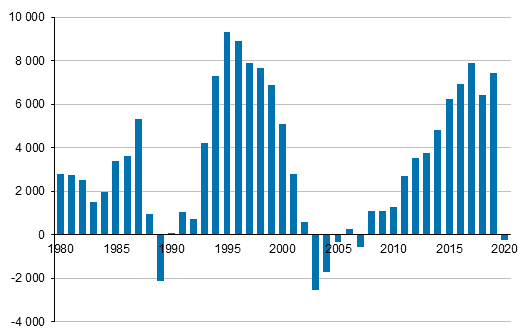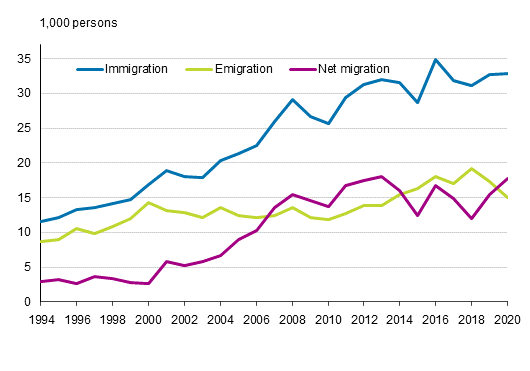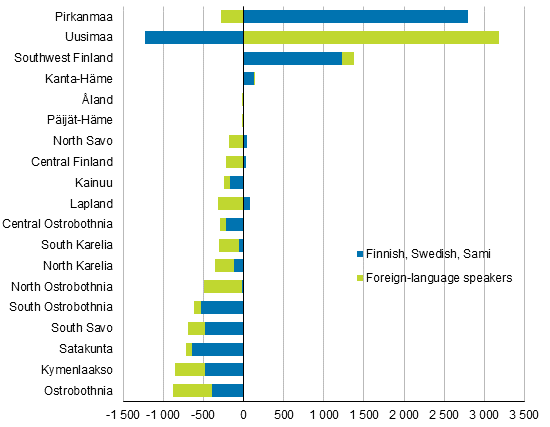Published: 12 May 2021
Greater Helsinki lost population to other parts of Finland in 2020
According to Statistics Finland, the combined total net migration of municipalities in Greater Helsinki was 6,752 persons, under one half of the previous year’s level. Total net migration includes migration gain from elsewhere in Finland and from abroad. In internal migration, migration in Greater Helsinki turned negative and migration loss was even historically high in Espoo.
Internal net migration of Greater Helsinki municipalities in 1980 to 2020

In 2020, the total net migration of the Greater Helsinki region was 6,752 persons, while in the previous year the region still received a migration gain of 13,867 persons. The gain from total net migration in Greater Helsinki was 8,297 persons for foreign-language speakers and the loss was 1,545 persons for those speaking national languages. Greater Helsinki lost 240 persons in internal migration. The internal migration loss of Greater Helsinki was caused entirely by those speaking national languages. The net migration of national language-speakers to Greater Helsinki was 2,129 moves negative, while the corresponding figure for foreign-language speakers was 1,889 positive.
Finland's migration gain from abroad grew for the second year in a row
Finland's migration gain from abroad rose to 17,814 persons in 2020, from 15,495 persons in the previous year. The reason for the higher migration gain was especially a decrease in emigration. The number of emigrants from Finland was 15,084, which is over 2,000 fewer than in the previous year. A total of 32,898 persons moved from abroad to Finland, good 100 persons more than in the year before.
Migration between Finland and other countries 1994–2020

Finnish citizens’ return migration highest in at least 30 years
Finland’s migration gain from foreign citizens was 16,705 persons, which is 94 per cent of Finland's total migration gain. After a long negative period, net immigration by Finnish citizens turned positive, 1,109 in 2020. Immigration by Finnish citizens rose by over one thousand to 9,638 moves and emigration declined by good one thousand to 8,529 moves in 2020. Immigration by Finnish citizens was highest in at least 30 years in 2020.
Most of Finland’s migration gain still came from those having moved from outside the EU
Finland’s migration gain consisted mostly of persons having moved from outside the EU. In 2020, Finland's migration gain from outside the EU totalled 13,730 persons, having been over 14,000 in the previous year. Migration gain from EU countries grew from the previous year's close on 2,000 to 4,146 migrants.
The immigration gain was largest among Russian citizens, 1,855 immigrants, and second largest among Iraqi citizens, 1,189 immigrants. The third largest immigration gain came from Finnish citizens, especially due to the large return migration of Finnish citizens.
Migration gain for regions from immigration
All regions received migration gain from international migration. Taking that into account, the number of regions with migration loss falls somewhat. The sum of net immigration and net internal migration was negative in seven regions.
Migration in Finland
Most migration gain for Pirkanmaa, biggest migration loss for Ostrobothnia
In 2020, the largest gain from internal migration was seen in Pirkanmaa, Uusimaa and Southwest Finland. Ostrobothnia, Kymenlaakso and Satakunta lost their population most to other parts of Finland through internal migration.
Uusimaa suffered historical migration loss of those speaking national languages
The migration gain of the region of Uusimaa from the rest of Finland was 1,950 persons in 2020. Examined by native language, the region of Uusimaa’s migration loss was over 1,200 persons speaking national languages. The migration gain for Uusimaa was nearly 3,200 persons from foreign-language speakers. During the past 30 years, Uusimaa has earlier lost national language speakers as migration loss only in 2003.
Internal net migration of regions by language in 2020

Pirkanmaa’s migration gain from elsewhere in Finland was fully based on those speaking national languages as their native tongue, because for foreign-language speakers Pirkanmaa experienced migration loss to the rest of Finland.
Kainuu and Lapland had the lowest migration losses in over 40 years
In 2020, the migration losses of the regions of Kainuu and
Lapland to the rest of Finland were smallest in over 40 years.
Lapland’s migration loss was 239 persons to the rest of
Finland.
Lapland's migration loss to the rest of Finland was last lower than
this in 1976.
Internal net migration in regions of Kainuu and Lapland in 1970 to 2020

For those speaking national languages, Lapland received migration gain for the first time in over 30 years. The migration loss of foreign-language speakers turned net migration to the rest of Finland negative.
Tampere and Vantaa received the biggest migration gains
Tampere (2,094 persons) and Vantaa (1,039 persons) received the largest migration gain from intermunicipal migration. The migration gain of Tampere consisted of persons speaking national languages, while in Vantaa it concerned foreign-language speakers. Migration gains of over 600 persons were also received in Kuopio (678 persons), Turku (659 persons), Kaarina (630 persons) and Oulu (619 persons).
Around one municipality in three received migration gain from migration within Finland, while in 2019 only one municipality in six got migration gain.
Helsinki and Espoo have the biggest internal migration losses
Migration losses from intermunicipal migration were biggest in Helsinki (1,044 persons) and Espoo (602 persons). In Espoo migration loss was biggest in over 70 years and in Helsinki since 2005. Espoo’s migration loss consisted of persons speaking national languages, while in addition to that, Helsinki’s migration loss was caused by foreign-language speakers. Migration losses were next biggest in Mikkeli (436), Kouvola (423) and Kotka (356 persons), which were the three biggest migration loss municipalities in 2019.
Examined in relative terms, migration loss was largest in the municipalities of Punkalaidun, Siikajoki and Siikainen.
Source: Migration 2020. Statistics Finland
Inquiries: Juhana Nordberg 029 551 3051, Markus Rapo 029 551 3238, Joni Rantakari 029 551 3401, info@stat.fi
Head of Department in charge: Hannele Orjala
Publication in pdf-format (303.0 kB)
- Tables
-
Tables in databases
Pick the data you need into tables, view the data as graphs, or download the data for your use.
- Figures
- Quality descriptions
-
- Quality description, migration 2020 (12.5.2021)
Updated 12.05.2021
Official Statistics of Finland (OSF):
Migration [e-publication].
ISSN=1797-6782. 2020. Helsinki: Statistics Finland [referred: 21.1.2026].
Access method: http://stat.fi/til/muutl/2020/muutl_2020_2021-05-12_tie_001_en.html

